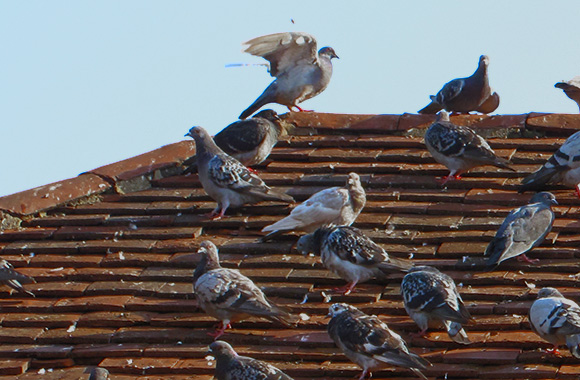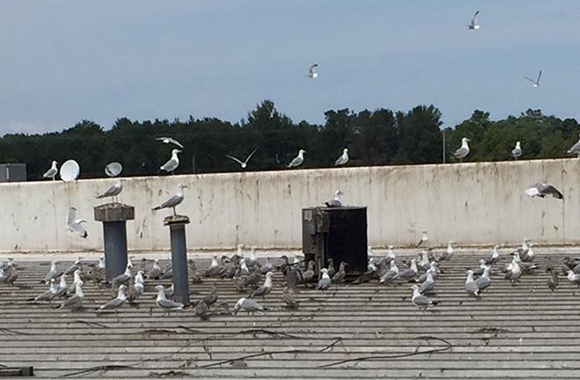How to keep birds off the roof
Birds can provide gorgeous scenery for you to watch and relax. However, this may turn out to be a rather difficult thing for you to handle when large flocks of birds are trooping to your home or property. That is the case when birds find the roof of your house too good place for them to sit and enjoy. Apart from the huge heaps of wastes they leave behind comes the risk of disease that they can carry and infect humans. There are more than sixty diseases associated to birds and their droppings - all of which pose substantial hazards to humans. Whatever the mess know that you can often get a way to chase the birds and keep them off your roof. Here are some pieces of advice you may find useful in your endeavor.


Play them some music - birds love to do some music on their own, but they are easily and quickly pissed off by specially designed digital sounds meant to break down their will. Special sound equipment that consists of sequences of birds in distress followed by predator sound will break the will of birds and feed them the notion that this is no place for them. Birds know when their friends are under attack and generating such an artificial environment on your roof will see them off sooner than later. There are more than a dozen digital devices you can employ to this end - just check online or from local stores.
Disturb their vision - Birds are credited with one of the best visual acuity levels among wildlife. They rely on their vision to identify prey and predator, landing and taking off as well as estimating distances. That makes their eyesight the main stay of their navigation capabilities. Messing with their vision distorts their world and they are not ready to wander where they can't accurately perceive the reality. Install some sphere flashes, ire tape and much more. Once they see a moving object that they perceive dangerous they won't risk coming any close to your roof.
Mess with their delicacy and they will have no reason to stay around. Birds could be using your roof as a resting place before they deploy to your garden to feed on the flower bud and some tasty grasses. Take the task to spray surrounding crops such birds love feeding on with methyl anthracite. This is an ecofriendly product that has been used for decades. It not only controls birds but several other pests as well. While, the birds may love the tastes of their favorite foods this spray will give them hell. Once they no longer find the sweet taste they are used too, they will rethink their long term stay.
Tamper with their roosts. Birds could already be having roosting places on or close to your roof. That means that they will still be on that roof every other day because roosting places are just nearby. To avoid this, tampering with their roosts will give them the feeling of insecurity. Remove their roosts carefully if there are no young ones or eggs in. Once birds know that their territory is constantly under surveillance and attack they will not wish to stay another day. They will be shifting their roosting points far and leaving your roof.
Bird spiders are another formidable tactic you can deploy against birds wreaking havoc on your roof. They are often attached on the roof top connect to HVAC units. These bird spiders consist of thick and highly reflective metals that revolve and shine bright light when they reflect light rays from the sun. This heavily tampers with the eyesight of the birds and makes the environment unbearable to these creatures, forcing them to look for alternative areas for the roosting.
Bird spikes are another good option when you need to make the birds on your roof has a hell day. The spikes are not as inhumane as the name may suggest, but rather aim to make the roof very uneven for the birds. When they cannot land safely and maintain balance then they won’t be thinking of coming back, they will be seeking to look for an alternative spot as soon as possible.
Bird gel can also be applied on the roof to ensure the birds making a home out of it have no such chance. Bird gel will make the roof surface sticky and slippery, denying the bird the much needed grip and balance. Birds themselves hate the feel of bird gel and once they feel it in their feet they will be yearning to fly away, never thinking to return again.
An electric jolt can all be applied to condition the birds to stay away. The electrical system is connected to the favorite spots of the birds and will give the birds a small unpleasant electrical shock once they attempt landing on this surface. Once they receive the jolt twice they won't attempt a third time, these creatures aren't stupid either.
Creating a bird feeder in the garden can also serve as a great distraction to the birds. Once they discover a free feeder for their use they won't be coming to rest freely on the roof when there is a treat running in the backyard. This will dissuade then from hanging out on the roof and keep them busy elsewhere. This can help ease the numbers perching on your roof at any given time.

You have a few options available when birds are landing or roosting on your roof and refusing to budge.
Spike strips are one of the obvious choices. These can be installed yourself if you have [safe] access to the roof and all tools. Otherwise, local wildlife removal experts that specialise in bird control will happily take on this job. The strips are installed on flat ledges and surfaces to prevent nuisance birds from being able to land there.
Bird wire is another choice, also suitable for straight areas. Rather than strips of spikes, thin wires are run along straight edges and similar areas, preventing birds from being able to physically land there. Installation of bird wire is best performed by experts to ensure that no birds are harmed.
Bird spider deterrents are moving, spinning deterrents that look like spiders, with lots of legs that protrude out and flail in the wind. These are often used for boat roofs, but can also come in quite handy on roof spaces where wires and spike strips are not feasible.
There are other approaches you can look at, of course. These include bird netting, which is good for wide, open roofs; bird gel, which isn’t recommended for smaller birds; and various repellents and deterrents, none of which work for long periods of time.

